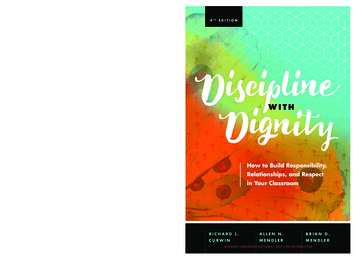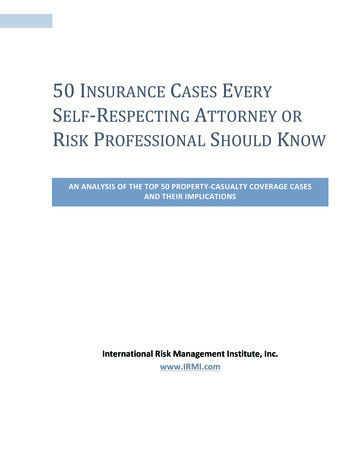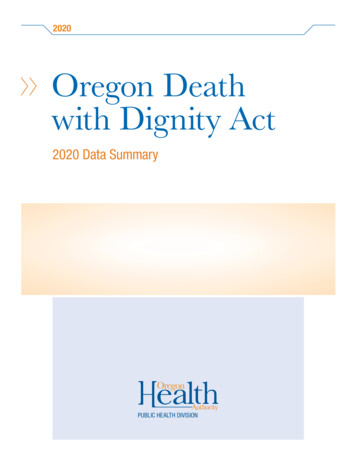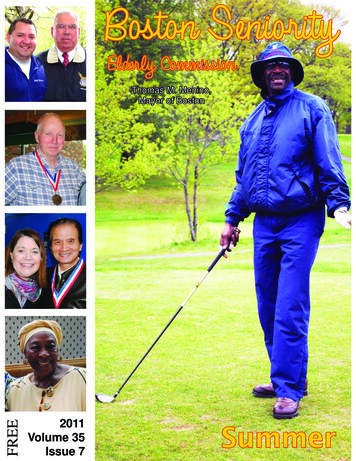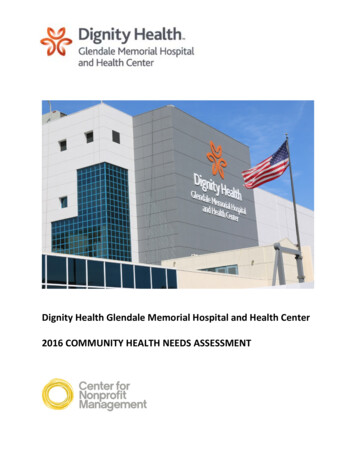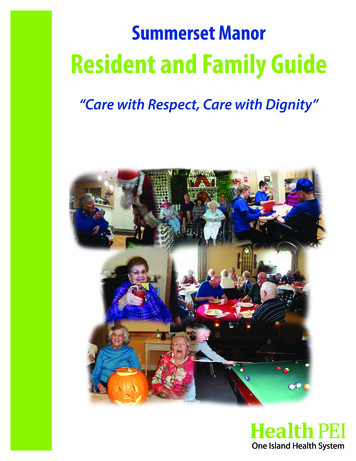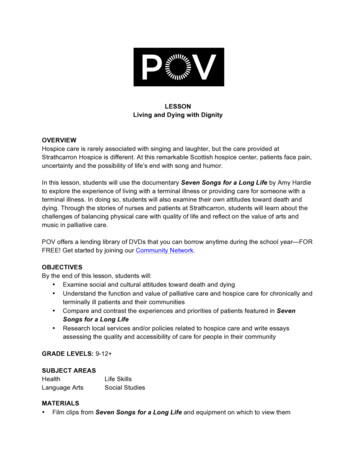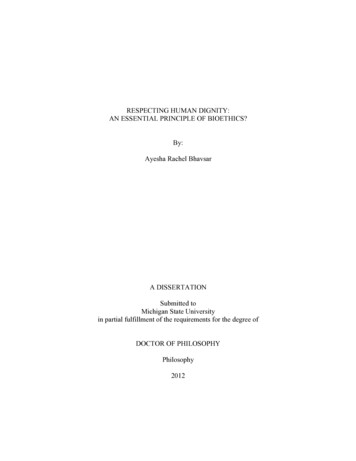
Transcription
RESPECTING HUMAN DIGNITY:AN ESSENTIAL PRINCIPLE OF BIOETHICS?By:Ayesha Rachel BhavsarA DISSERTATIONSubmitted toMichigan State Universityin partial fulfillment of the requirements for the degree ofDOCTOR OF PHILOSOPHYPhilosophy2012
ABSTRACTRESPECTING HUMAN DIGNITY:AN ESSENTIAL PRINCIPLE OF BIOETHICS?By:Ayesha Rachel BhavsarIn my dissertation I argue that bioethics should not continue to hold the concept of ‘humandignity’ in its current esteemed status. The meaning of ‘human dignity’ is rarely elucidated, yetthe principle of respecting dignity has been considered the “shaping principle” of bioethics sincethe Nuremberg trials, and is routinely appealed to in justifying the constraint, condemnation, orapproval of controversial biotechnologies and pivotal policy recommendations that often havefar-reaching implications. For instance, the President’s Council on Bioethics, UNESCO’sUniversal Declaration on the Human Genome and Human Rights, the Danish Council ofBioethics, and the World Medical Association all hold respect for human dignity as afundamental moral principle which, in turn, has great bearing in their policy recommendations.In surveying these and other literatures, I show that people have conflicting moral intuitionsabout (1) what grounds dignity, (2) who are its bearers, and (3) what it means to violate or tosafeguard human dignity. After arguing that respect for human dignity is an ineffective actionguiding principle, and should not be considered a foundational principle, I set out to address thefollowing question: What role, if any, should dignity have in bioethics? I put forth a taxonomy ofdignity functions, which works to disambiguate dignity language and provide a framework withwhich we may attend to this question. After this inquiry and reflection, I conclude that dignity islargely beside the point in bioethics and that persons’ having interests and corresponding moralentitlements is what’s really at stake. While my taxonomy of dignity functions is useful in
evaluating the appropriate moral weight of dignity in pre-existing discourses, in looking to thefuture, bioethics would be better served if it moved away from such heavy reliance upon‘dignity.’
DedicationThis dissertation is dedicated to Harold Kaplan, my grandfather.Olav HaShalom- (May he rest in peace)iv
ACKNOWLEDGMENTSI would like to acknowledge my advisor, Hilde Lindemann, as well as my parents, my entirefamily, and my dear friends and colleagues: Sarah Schmidt and Alexandra Valadas for theirconstant support. I would also like to acknowledge Fred Rauscher, Deborah Nails, and TamraFrei. Above all, I must express my eternal gratitude to HaShem.v
TABLE OF CONTENTSCHAPTER 1:THE MORAL STATUS OF HUMAN DIGNITY AND ITS UBIQUITOUS USEPrevalence and Vagueness of Dignity Language Within the LiteratureDignity at the End of LifeDignity in Our GenesDignity and Growth AttenuationDignity in CloningDignity in NursingArguments that Equivocate on ‘Dignity’ConclusionWorks CitedCHAPTER 2:THE FUNCTIONS OF DIGNITYWürde: Kantian DignityBiblical Dignity and the Sanctity of LifeDignitas: Greco-Roman DignityDignity as Protecting AutonomyDignity as Prohibiting Instrumentalization, Commodification, andExploitationDignity as Preserving the Sanctity of Human LifeSocial DignityConclusionWorks CitedCHAPTER 3:USING THE TAXONOMY TO DETERMINE THE APPROPRIATE WEIGHTOF “HUMAN DIGNITY”Using the Taxonomy to Identify Instances of EquivocationCases where Dignity is Reducible to Less Ambiguous Concepts orAction-Guiding PrinciplesSocial DignityHolding Another’s DignityHolding the Dignity of Those Who Lack (and have AlwaysLacked) AgencyHolding the Dignity of Those with Diminished AgencyDignity as Sanctity of Life: A Trojan Horse for Religious AssumptionsConclusionWorks 99109114121125134136
CHAPTER 4:DIGNITY AND BEYOND: IMPLICATIONS FOR FUTURE DISCOURSESWhy Dignity? A Brief HistoryWhat Purpose does Dignity Serve?Why It isn’t Necessary to Ground Universal Human Rights in HumanDignityAn Alternative Approach to Grounding Moral ConsiderationUsing My Alternative Approach Instead of the Dignity ModelWhy the Future of Bioethics would be Better Served with Less Relianceupon Dignity LanguageConclusion: Although Dignity is Largely Beside the Point in Bioethics, Itisn’t Altogether UselessWorks Citedvii139141143146148157164167171
Chapter 1: The Moral Status of ‘Human Dignity’ and Its Ubiquitous UseBioethics should not continue to perfunctorily hold ‘dignity’ in its current status. Carrying greatmoral weight, the meaning of ‘human dignity’ is rarely elucidated, yet the concept is routinelyused as blanket justification for the general condemnation or constraining of controversialmedical decisions and biotechnologies. Because ‘dignity’ weighs too heavily in moralconsiderations of both private medical decision-making and public policy discourse, we ought toquestion its authority in grounding pivotal policy recommendations that have far-reachingimplications. While dignity is not an entirely useless concept in bioethics, more attention oughtto be paid to instances where it is merely asserted and has great normative strength, or caseswhere it amounts to little more than an articulation of general social unease with a givensituation. In particular, I am critical of arguments where assumptions about dignity are used as aconversation stopper, effectively allowing for the evasion of further debate. Such arguments thatrely heavily upon dignity tend to conjure emotional responses and corresponding normativeexpectations about who/what is to be included in considerations of which sorts of entities arebearers of dignity, what bearers of dignity are entitled to, and what grounds human dignity. Thiscan lead to unreasonable decisions that are made in the name of safeguarding human dignity,which is at times potentially harmful to patients, familial caregivers, and, in the case of publicpolicy, potential subjects.In this chapter, I highlight the prevalence of dignity language in the bioethics literature,showing that dignity is used to ground pivotal decisions in the public policy sphere that, in turn,have ramifications in the private domain of medical decision-making. The numerous examplesthat affirm the pervasiveness of dignity as an overarching principle demonstrates the vaguenessof the concept and the need for elucidation if one is to justify keeping dignity’s current status as a1
fundamental principle of bioethics. By overarching principle, I mean that respect for dignityseems to encompass all kinds of action-guiding principles, such as respect for patient autonomy,veracity, beneficence, distributive justice, non-maleficence, informed consent, and so on. Indrawing attention to the wide range of cases where dignity is asserted without any argumentwhatsoever about what it entails or who is a bearer of it, my aim is to problematize the role thatdignity plays in granting corresponding entitlements or requiring/disallowing particular actionsor behavior. To do this I provide examples that (1) illustrate the expansive use and imprecisenessof dignity language, and (2) equivocate on the word ‘dignity.’I. Prevalence and Vagueness of Dignity Language Within the LiteratureSince the1948 Universal Declaration of Human Rights, which acknowledges the “inherentdignity” of all members of the human family, heavy reliance upon the concept of human dignityhas led scholars to characterize it as “the shaping principle” of international bioethics (Andorno2009, 227). Institutions and boards such as the President’s Council on Bioethics (PCB), variousUnited Nations organizations, the World Medical Association (WMA), and other policy makersappeal to human dignity in addressing a multitude of issues. For instance, the PCB appeals tohuman dignity in discussing the dignity of the uniqueness of humans (which is threatened byresearch that aims to produce animal-human chimeras), the dignity of bodily integrity (which isthreatened by enhancements and interventions that are seen as ‘unnatural’ or displaying hubris),the dignity of psychic integrity, (which is threatened by chemical interventions that cantransform personal identity), the dignity of human excellence (which is threatened by reliance onperformance-enhancing drugs), the dignity of dying well (which is threatened by excessivemedical interventions), the dignity of human life (which is threatened by euthanasia and otherinterventions that prematurely end the natural course of human life) and the dignity of the human2
life cycle (which is threatened by research for methods that would conquer mortality or slowaging) (Kass 2008, 195). The United Nations Educational, Scientific, and Cultural Organization(UNESCO) Universal Declaration on the Human Genome and Human Rights (UDHGHR) holdsrespect for human dignity as a fundamental moral principle in creating policies that protect thedignity of procreation, which may be threatened by cloning and other reproductive technologies(2003). The Danish council of bioethics relies upon dignity language in assuming the dignity ofnascent human life (which is threatened by exploiting human embryos, treating them as rawmaterial, a means that can be used in commerce and research). Similarly, in disallowing thepatenting of human genetic material, the Danish council views the commodification of humangenes as a profound affront to human dignity (2004). The WMA International Code of MedicalEthics uses the language of dignity to ground physician’s conduct, stating that physicians have aduty to practice medicine “with conscience and dignity” as well as protect and respect the dignityof human subjects (Van Der Graaf and Van Delden 2009, 151). In each of these cases, ‘dignity’is explicitly mentioned, its connotation eliciting emotionally charged responses. From theseexamples, we begin to see that the rhetoric of dignity refers to a number of things without everbeing clearly defined and is used in a way that is meant to be prescriptive.Given that a word’s meaning is in its use, as Wittgenstein argues in his PhilosophicalInvestigations, an overview of bioethics literature reveals that the meaning of dignity is muchmore complex than one might imagine. In analyzing the (sometimes conflicting) ways in whichhuman dignity is used in debates about controversial biotechnologies and regulatory constraint, Ihighlight the vast confusion that arises within the literature to show that in its current usage,‘respect for dignity’ is not an effective action-guiding principle.3
Dignity at the End of LifeIn surveying the literature on euthanasia/end-of-life decisions, patents on human geneticmaterial, controversial biotechnologies such as growth attenuation, human cloning, and nursingethics I will show that people have conflicting moral intuitions about (1) what grounds dignity,(2) who are its bearers, and (3) what it means to respect, safeguard, or violate human dignity. Iwill argue that even within a given meaning of dignity, the concept can be so imprecise that itmay be used to support contradictory conclusions. My examples highlight the lack of rigor andimpreciseness in applying the concept to show that people have conflicting moral intuitionsabout what it means to die with dignity. I argue that dignity is used as a rhetorical device inslogans such as “death with dignity” and that such slogans should be treated with skepticism.Human dignity appears in the euthanasia/end-of-life literature in a number of guises,many of which are potentially at odds with one another. Both those who are in favor ofregulatory euthanasia and those who categorically oppose it appeal to dignity language ingrounding their arguments. Hence, in this context, the concept of dignity does no real work, as itsclichéd, imprecise use lends itself to supporting contradictory conclusions. Consider, forexample, the following statement: “Smith wishes for a death with dignity.” One mightimmediately conjure a very distinct image of what one takes to be the quintessential dignifieddeath. What does such a death look like? Some would take the image of a Socrates-like or Zenmonk type sage who faces death with courage and acceptance to be the epitome of what it meansto die with dignity. Such a death would allow for Smith to say his farewells, speak his finalwords (which perhaps includes prayer or coming to terms with the Creator), and give him a senseof overall closure. For others, the conditions leading up to death are of utmost importance. Here,being hooked up to artificial life support, appearing unkempt, being utterly dependent upon4
others, experiencing prolonged psychological and/or physical suffering, and so on, are all factorsthat would seemingly threaten Smith’s desire to die with dignity. Dan Callahan’s “natural death”might be what Smith has in mind in expressing his wish to die with dignity. A “natural death” isone variation of an ideal death where “(1) one’s life-work has been accomplished; (2) one’smoral obligations to those for whom one has had responsibility have been discharged; (3) thedeath will not seem to others an offense to sense or sensibility or tempt others to despair and rageat human existence; and finally, (4) the process of dying is not marked by unbearable anddegrading pain” (1979, 164). In this vein of emphasizing the significance of the conditions whileone is still living, respecting Smith’s autonomy might be of utmost importance in fulfilling hisdesire to die with dignity. It is honoring his decision, whatever it might be, that allows Smith todie with dignity. Others might retort that the sanctity of human life dictates that tampering withnature, in the form of euthanasia, would violate Smith’s wish, as death with dignity is somethingthat can only be left to the Creator. Still others might argue that Smith’s wish is nonsensical, asdeath is the ultimate indignity, making it impossible for anyone to die with dignity. From thispreliminary discussion, we begin to see some of the confusions that arise just within theeuthanasia literature. In what follows, I critically analyze several important philosophicalarguments that rely heavily upon dignity language in order to problematize dignity’s currentusage in the end-of-life literature. In analyzing the first of these arguments, as found in J. GayWilliams’s “The Wrongfulness of Euthanasia,” I argue that the concept of dignity can be sovague that it can be used to support opposing positions.In “The Wrongfulness of Euthanasia,” Williams’s “argument from nature” claims that“euthanasia does violence to our dignity” He argues for the wrongfulness of euthanasia byassuming a teleological view of human nature, where survival is a natural goal that all of nature’s5
processes aim toward. Assuming a particular notion of dignity where “our dignity comes fromseeking our ends,” Williams views euthanasia as setting us against our very nature, the goal ofsurvival being a basic human characteristic (2010, 205). As such, euthanasia wrongfully violatesour dignity. Williams’s argument from nature can be summarized as follows:P1. It is wrong to violate any human being’s dignity.P2. Dignity comes from seeking our ends.P3. Survival is the most basic end of all. All natural processes aim toward this naturalgoal of bodily survival.P4. Euthanasia defeats this natural, most basic end.C. In preventing the seeking of our ends, euthanasia violates a human being’s dignity,making euthanasia morally wrong.If one were to grant the assumption that dignity is grounded in and upheld by seeking ourends, but disagree with Williams about the truth of P3, we might use this very notion of dignity,as expressed in P2, to instead advocate respect for autonomy. Suppose one grants that dignitycomes from seeking one’s ends, but rejects the idea expressed in P3 that survival is a naturalbodily goal. This same meaning of dignity may be used to lead to opposing conclusions. Onemight reject P3 on the grounds that it assumes the naturalness of survival in spite of the fact thatdeath is natural and inextricably tied to life. Even Socrates advocated the naturalness of death,acknowledging that from birth, nature condemns us all to death (Veatch 1989, 238). Clearly, notall natural processes are bent toward bodily survival. For example, when cancer or diseaseplague the body we observe the natural deterioration of bodily processes. Given these problemswith P3, one might instead take this meaning of dignity as the satisfaction of ends to advocaterespect for autonomy. As the satisfaction of ends in the case of autonomy involves allowing6
agents to exercise volition, interference with another’s autonomy prevents the seeking of ends,and as such, is an affront to a person’s dignity. Hence, in respecting another’s autonomy, onewould have to honor the decision to seek euthanasia. From this example we see that the conceptof dignity is at times too vague to be useful in that it can be used to support opposingconclusions. In the following examples, I contrast arguments in the euthanasia literature thatemploy different assumptions and understandings of dignity to show that in looking at its usage,the meaning of dignity remains so imprecise and unclear that slogans such as “death withdignity” amount to little more than a rhetorical device.Perhaps the most famous “death with dignity” slogan, as found in Oregon’s Death withDignity Act, takes respect for autonomy as a fundamental action-guiding principle in upholdingthe right to a “death with dignity.” This popular usage views dignity as involving the protectionof autonomy, where the scope of autonomy includes control over the amount and duration ofpsychological and/or physical suffering that one is willing to endure during the final stages ofone’s life. Along similar lines as Oregon’s Death with Dignity Act, Marvin Kohl assumes ameaning of dignity where dignity amounts to “the actual ability of a human being to rationallydetermine and control his way of life and death and to have this acknowledged and respected byothers” (McCullough 1979, 127). In “A Plea for Beneficent Euthanasia,” Kohl argues for themoral permissibility of both passive and active euthanasia, viewing both types as respecting theright to die with dignity, after the beauty and meaning of life have vanished (1974, 4-5). ForKohl, the ultimate indignity is for a person to lack control over the significant aspects in his orher life and be required to endure pointless and prolonged agony, decay, and suffering (1992,40).7
This usage of “death with dignity” does not focus narrowly on the moment of deathitself, but gives significant consideration to the state that precedes death. As such, it focuses ondignity as the protection of autonomy, which includes having choice in satisfying a thresholdlevel of lifestyle conditions that precede death. Contrary to the conservative supposition that painor the prospect of physical suffering is the primary reason for seeking euthanasia (and that betterpalliative care, not death, is the appropriate solution), individuals seeking euthanasia reportfeeling more apprehensive in anticipation of their impeding loss of dignity than troubled by theprospect of physical suffering (Caplan, Snyder, and Faber-Langendoen 2002, 40). Take, forexample, a patient recently diagnosed with Alzheimer's disease. Such a patient might envisionherself becoming incapable of living the full and independent life that she has cherished, the lifethat had defined her identity. She pictures herself unkempt, wasting away, painfully forgetful,being utterly dependent upon her partner for the most basic of needs, her self-esteem beingstripped away alongside her dignity as her ability to make wise decisions that are consistent withher identity diminishes as does the capacity for basic self-care, i.e. going to the bathroom,feeding, bathing, and dressing herself. Living in such a state for the duration of what could bemonths or even years could be viewed as an unbearable loss of dignity. Nietzsche’s desire to “dieproudly when it was no longer possible to live proudly” embodies this sentiment (Coops 1997,38). Hence, “death with dignity” seems to very clearly require respect for patient autonomywithin the context of a subjective valuing of some threshold level of lifestyle conditions that areconsistent with an individual’s understanding of what it means to live and die in a dignifiedmanner. This meaning, what I refer to as the “popular” interpretation, is just one use of “deathwith dignity.” In what follows I survey the anti-euthanasia literature to show alternateinterpretations and highlight confusions that arise around “death with dignity” rhetoric.8
At first blush, the popular understanding might seem like the obvious interpretation of“death with dignity.” However, the anti-euthanasia literature discredits the merit of this sloganby arguing, for example, that the phrase doesn’t really make sense in that pondering the finitudeof one’s life is in itself an indignity, or that a dignified death requires a certain dignity of soulthat cannot be conferred by others via euthanasia, or, that given the sanctity of human life,euthanasia would in fact violate human dignity. In “The Indignity of Death with Dignity,” PaulRamsey contends that the slogan “death with dignity” doesn’t make sense, as death is tooprofound a blow to our selfhood to allow for the possibility of anyone’s dying with dignity.While there might be dignity in the humanistic act of caring for someone who is dying, there isno dignity to be found in dying itself (Ramsey 1974, 48). According to Ramsey, death poses acontradiction to the unique and inalienable worth of an individual life (1974, 47). Euthanasia,meaning “good death” is contradictory in terms, as is the expression “good grief” (Ramsey 1974,48). Death means the annihilation of our time being alive. This means that it is impossible toexperience death, since experiencing something requires being alive. Better put, as Wittgensteincomments in the Tractatus, “Our life has no limit in just the way in which our visual field has nolimit” (6.4311). A dying person’s awareness of this causes him or herself to experience theultimate indignity (Ramsey 1974, 50). Hence, the popular understanding of the phrase “deathwith dignity” is actually nonsensical. Instead of assuming that “death with dignity” goes hand inhand with pro-euthanasia campaigns, greater emphasis should be paid to suffering with dignity,as that occurs while one is living and is something that can be done with dignity (Ramsey 1974,48).Although Ramsey and Leon Kass have different understandings of what “death withdignity” means, both interpretations are incompatible with the meaning of dignity as implied in9
Oregon’s Death with Dignity Act and other similar uses. In “Death with Dignity and the Sanctityof Life,” Kass acknowledges the difficulty in deciphering what dignity requires of us in the caseof voluntary euthanasia, stating that “euthanasia for one’s own dignity is, at best, paradoxical,even self-contradictory: how can I honor myself by making myself nothing? Even if dignitywere to consist solely in autonomy, is it not an embarrassment to claim that autonomy reaches itszenith precisely as it disappears?” (Kass 1990, 41). In “Defending Human Dignity,” Kass regardsAchilles and Socrates as exemplars of heroic dignity, displaying courage and wisdom in the faceof human mortality. Seeing the desire for euthanasia as a lack of courage, Kass rhetorically asks,“Is it really dignified to seek to escape from troubles for oneself? Is there, to repeat, not moredignity in courage than in its absence?” (Kass 2002, 251). On this view, the possibility of facingdeath with dignity requires a “dignity of soul” that can only be found within the person, and issomething that others cannot confer (Kass 1974, 70). As such, respect for autonomy in the formof allowing euthanasia, does nothing for the patient’s dignity, as death with dignity requires acertain character of soul that can only come from within the dying person and cannot be given orconferred by others. Hence, Kass’s use of dignity is something very different from whatOregon’s meaning implies, rendering the possibility of death with dignity somewhat of a raritythat only people of stellar moral character are able to experience. In looking at Ramsey and Kasswe see that the popular understanding, upon further scrutiny, is not the undoubtedly correctmeaning. Ramsey and Kass are two examples where interpretations of the “death with dignity”slogan are incompatible with the popular understanding.On yet another understanding of “death with dignity,” euthanasia is a type of death that isan affront to human dignity. Ronald Dworkin makes this point in Life’s Dominion where heargues against the moral permissibility of abortion and euthanasia by assuming a sanctity-of-life10
meaning of dignity. On this view, each human life has an innate value, an intrinsic worth thatnever diminishes. Euthanasia is seen as an insult to this inalienable worth. John Locke opposedsuicide on the grounds that we are all mere tenants in life; our lives are the property of God. Assuch, suicide is a form of embezzlement or theft. It offends the inviolability of human life, aninsult to the ultimate gift from God: life itself (Dworkin 1994, 195). Similar lines of thought areused in court cases that deal with end-of-life decisions. For instance, in reference to the NancyCruzan case, Judge Rehnquist condones Missouri’s strict burden of proof, claiming that stateshave an interest in preserving human life, even when doing so might not be in the patient’spersonal best interest. For those states that view euthanasia as an insult to the sanctity of humanlife, Rehnquist assumes that showing respect for the intrinsic value of human life trumpspersonal interests as well as respect for autonomy. Justice Scalia concurs, granting states theauthority to prohibit all forms of euthanasia, even in the case of acute suffering, becauseprotecting the sanctity of human life is of utmost importance (Dworkin 1994, 198). Hence, suchstates would be justified in their prohibition of euthanasia in order to promote human dignity.Similarly, in a Canadian assisted suicide case (Sue Rodriguez), Supreme Court Justice Sopinkarhetorically asked: “As members of a society based upon respect for the intrinsic value of humanlife and on the inherent dignity of every human being, can we incorporate within the Constitutionwhich embodies our most fundamental values a right to terminate one's own life in anycircumstances?" (Pullman 1996, 2). Justice Sopinka and others fear that euthanasia will insult thevalue of life, eroding society's perception of the inalienable worth of human life in general(Pullman 1996, 50).In reviewing the euthanasia literature I have shown that conflicting positions invokeconsiderations of dignity at the core of their respective positions. I have drawn attention to the11
imprecise use of dignity as a concept, while underscoring some of the problems that arise withsuch reliance upon dignity language. Namely, that it does no real work in elucidating what weought to do. Even within a single meaning, the concept can be used to support opposingpositions, and therefore, is not an effective tool in moral deliberations. In looking at the “deathwith dignity” pro-euthanasia literature and the anti-euthanasia literature, the concept of dignity isused both to argue in favor of autonomous choice and against the devaluation of human life thateuthanasia is said to imply. Hence, in cases such as Oregon’s Death with Dignity Act, we see“dignity as empowerment” and in anti-euthanasia arguments that view euthanasia as an insult tothe sanctity and dignity of human life, we see “dignity as constraint” with regard to the rights andregulations that these meanings are intended to require (Beyleveld and Brownsword 2001, 1829). Given the conceptual ambiguity of dignity and of slogans such as “death with dignity,” theseseemingly contradictory properties render it a concept that people tend to apply without anyrigor, making it more confusing than useful.Dignity in Our GenesIn debates about the appropriateness of patenting human genetic material, we see a verydifferent, although equally hand-wavy, application of “human dignity” from the one we see inthe euthanasia literature. In the debate on the ethics of patenting human genetic material, dignityis placed in opposition to the instrumentalization of human material and the devaluation ofhuman life that such commodification is said to imply. As an action-guiding principle, suchreliance upon dignity language is problematic in this discourse because it assumes a great dealabout the intrinsic specialness of the human species. It therefore does no real work for someonewho doesn’t take for granted the unique status of humans as being something that endows humangenetic material with certain inalienable entitlements that human persons enjoy.12
There are two distinct, but related, insults to dignity that are at play in this discourse. Thefirst can be called the ‘commodifiation’ or ‘instrumentalization’ affront, and is associated withKant’s second formulation of the Categorical Imperative. The second can be called “symbolicdevaluing,” and draws on claims about the inherent uniqueness and worth of the human speciesas a collective entity. In the first sense, dignity-based commodification concerns assume thattreating people as ends in themselves and not as mere means is a key component in upholdingdignity (Caulfield and Brownsword 2006, 74). Here, dignity is rooted in the Kantian notion ofdignity as Würde, where human beings are not replaceable in the way that things and animals aresaid to have a replaceable value. In his Lectures on Ethics Kant wrote: “But so far as animals areconcerned, we have no direct duties. Animals are there merely
fundamental principle of bioethics. By overarching principle, I mean that respect for dignity seems to encompass all kinds of action-guiding principles, such as respect for patient autonomy, veracity, beneficence, distributive
